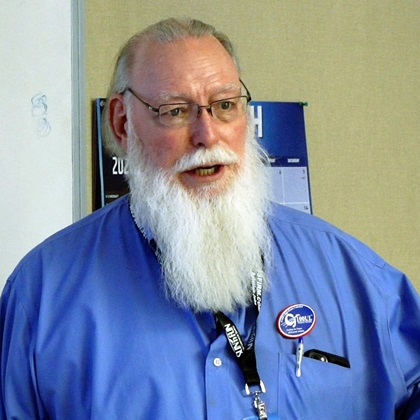GAMI reports unleaded fit for big-block engines
Company calls on FAA to approve G100UL STC
George Braly, chief engineer at General Aviation Modifications, Inc., called on the FAA to issue his company a supplemental type certificate to allow his 100-octane unleaded fuel to be used in essentially every spark-ignition engine and every airframe powered by those engines.
At a seminar at the Sun ’n Fun Aerospace Expo in Lakeland, Florida, on April 5, Braly said he has completed every test required for the approval, has sign-off from various levels of the FAA, and was advised on March 3 by the FAA Wichita Aircraft Certification Office (ACO) that the fuel was ready for approval:
“GAMI has completed all necessary ‘showings’ and ‘findings’ of compliance and has provided the type design data and documentation required for the substantiation of the requested expansion of Aircraft STC SA01967WI. The AML [approved model list] for this STC will be revised to include those aircraft currently approved for operation on 100LL fuels, lower octane leaded and unleaded aviation gasolines, and MOGAS, to allow operation on GAMI G100UL high octane unleaded aviation fuel," the local FAA office wrote to Braly. "The revised AML currently awaits FAA HQ approval to sign and issue.”

Braly said a subsequent March 14 message from the Wichita ACO further advised that FAA regulations entitle an applicant to be issued an STC if they meet the requirements already met by GAMI. The portion of the ACO message shared by Braly concludes that “Therefore; an immediate approval of the expanded Aircraft AML STC SA01967WI is thus warranted.”
Braly, who is never bashful about his position, appears to be using communication from one level of the FAA to call out the Washington headquarters staff’s reluctance to issue the AML STC.
Earl Lawrence, executive director of FAA aircraft certification services in Washington, handed Braly an STC for his G100UL fuel at EAA AirVenture Oshkosh last summer. That STC covered a small number of Cessna 172 engines and airframes, but was the first such unleaded fuel STC ever issued. A few months later, the agency provided an expanded AML that covered essentially all low-compression engines.
Meanwhile, Braly said he had completed all the testing necessary to demonstrate the safe use of the fuel in all high-compression engines and airframes as well. To verify that, the FAA in December 2021 ordered the Atlanta ACO to conduct a certification review of the Wichita ACO’s and the “previous ACO’s” 12-year history of the G100UL AML STC process. In January, the Atlanta ACO concluded that the process met the required standards and “is suitable for FAA approval.”
Not surprisingly, Braly sees that as a stalling tactic, given the level of review and scrutiny already required by the FAA. Standing up a technical advisory board is normally something done at the start of a certification process, not at the end. Braly says he has been through the equivalent of six TAB reviews over the past decade, including some with as many as 40 FAA subject matter experts in the room. He claims the FAA is using the TAB process inappropriately, since it was mandated by Congress for review of projects for aircraft of 150,000 pounds or more—and resulted from the Boeing 737 Max accident reviews.
While GAMI and Swift Fuels have proceeded with efforts to have their high-octane unleaded fuels approved through the STC process, the FAA has also kept alive the Piston Aviation Fuels Initiative process for other potential fuel candidates. The PAFI process was conceived a decade ago in cooperation with industry to find an unleaded fuel suitable for the entire GA fleet. Although several companies, including Swift, entered fuels into the process, none emerged as viable candidates.
The FAA says several fuels are still under consideration through PAFI.
The agency and industry in February officially launched the EAGLE project—Eliminate Aviation Gasoline Lead Emissions, an industry, government partnership to prepare the manufacturing and distribution infrastructure for new unleaded fuels. The EAGLE kickoff meeting was held in Washington, D.C., in March and was attended by Braly and Chris D'Acosta of Swift, as well as representatives from various airframe, engine, propeller, and fuel providers.
At Sun ’n Fun, Braly said the AML STC he has applied for covers all spark ignition piston engines in the FAA’s type certification database, “without exception.” That is over 1,800 various makes and models of engines, including those of the large WWII engines and the post-war airline radial engines. His AML airframe STC is 51 pages long, Braly said, and again includes all aircraft in the FAA database that incorporate any of the engines listed in the engine AML.
According to Braly, all that is left to be done is for FAA HQ staff to authorize the Wichita ACO to sign the STC documents.
Meanwhile, Braly has been working with Avfuel to develop relationships with fuel refiners and blenders so that G100UL can be mass produced. So far it has been blended in only small batches for testing purposes. A company press release states, “GAMI anticipates G100UL avgas supply will meet North America’s demand for high-octane aviation gasoline within the next several years.”
Working closely with all participants involved in developing an unleaded fuel for the entire fleet, AOPA has developed a web portal with additional explanatory information and answers to frequently asked questions, including questions about the potential cost of a new fuel, how it might be distributed, and whether it might impact aircraft performance. Check it out at aopa.org/100UL.




